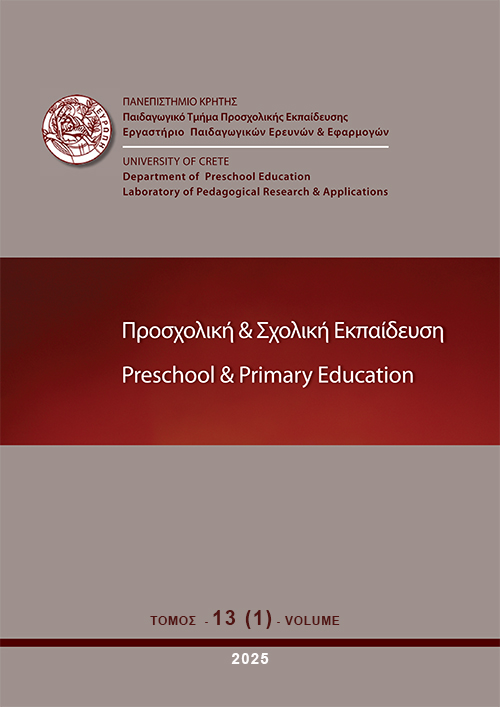Ο ρόλος της συναισθηματικής ρύθμισης των δάσκαλων Δημοτικού Σχολείου στη διαπροσωπική σχέση με τους μαθητές τους

Περίληψη
Η σχέση δασκάλου-μαθητή θεωρείται καθοριστική για την κοινωνική και ακαδημαϊκή εξέλιξη του μαθητή. Φαίνεται όμως να επηρεάζεται από τα συναισθήματα των εκπαιδευτικών και συνεπώς από την ικανότητά τους να τα ρυθμίζουν αποτελεσματικά. Για να εξετασθεί αυτό τέθηκε ως σκοπός της παρούσας μελέτης να διερευνηθεί ο ρόλος δύο σημαντικών στρατηγικών συναισθηματικής ρύθμισης των εκπαιδευτικών (γνωστική αναπλαισίωση και εκφραστική καταστολή) (Gross & John, 2003) στη διαμόρφωση δύο κρίσιμων παραγόντων της ποιότητας της σχέσης μεταξύ δασκάλου-μαθητή, της εγγύτητας και της σύγκρουσης (Pianta, 2001). Σχεδιάστηκε μία εκ των υστέρων μελέτη για τη σύγκριση των δύο στρατηγικών, ως προς τον ρόλο που έχουν στην ποιότητα σχέσης δασκάλου-μαθητή, σε τέσσερις διαφορετικούς τύπους μαθητών, βασισμένους στην επίδοσή τους και στη σχέση τους με τον/την εκπαιδευτικό. Ενενήντα δύο δάσκαλοι Γενικής Εκπαίδευσης συμπλήρωσαν κατάλληλα διαμορφωμένα ερωτηματολόγια τόσο για την αξιολόγηση της συναισθηματικής τους ρύθμισης όσο και για την αξιολόγηση της σχέσης τους με καθένα από τα 4 παιδιά της τάξης τους που πληρούσαν τα κριτήρια των 4 διακριτών τύπων (καλύτερες και χειρότερες μαθησιακές επιδόσεις, καλύτερη και χειρότερη ποιότητα σχέσης μαζί τους). Σημαντικό εύρημα μεταξύ άλλων, είναι ότι οι δάσκαλοι τείνουν να χρησιμοποιούν περισσότερο τη γνωστική αναπλαισίωση, η οποία συσχετίζεται με την εγγύτητα στους περισσότερους τύπους μαθητών. Τα συμπεράσματα διευρύνουν τους ορίζοντές μας για τη σημασία της χρήσης στρατηγικών συναισθηματικής ρύθμισης από τον εκπαιδευτικό, ώστε να διαμορφώνει υγιείς σχέσεις με τους μαθητές που θα καλλιεργούν αποτελεσματικότερα τις ακαδημαϊκές και κοινωνικές τους δεξιότητες.
Λεπτομέρειες άρθρου
- Πώς να δημιουργήσετε Αναφορές
-
Στριλιγκά Μ., & Μανωλίτσης Γ. (2025). Ο ρόλος της συναισθηματικής ρύθμισης των δάσκαλων Δημοτικού Σχολείου στη διαπροσωπική σχέση με τους μαθητές τους. Preschool and Primary Education, 13(1), 1–28. https://doi.org/10.12681/ppej.38476
- Ενότητα
- Άρθρα

Αυτή η εργασία είναι αδειοδοτημένη υπό το CC Αναφορά Δημιουργού – Μη Εμπορική Χρήση – Παρόμοια Διανομή 4.0.
Οι συγγραφείς των άρθρων που δημοσιεύονται στο ΠΡΟΣΧΟΛΙΚΗ & ΣΧΟΛΙΚΗ ΕΚΠΑΙΔΕΥΣΗ διατηρούν τα δικαιώματα πνευματικής ιδιοκτησίας επί των άρθρων τους, δίνοντας στο περιοδικό το δικαίωμα της πρώτης δημοσίευσης. Άρθρα που δημοσιεύονται στο ΠΡΟΣΧΟΛΙΚΗ & ΣΧΟΛΙΚΗ ΕΚΠΑΙΔΕΥΣΗ διατίθενται με άδεια Creative Commons 3.0 και σύμφωνα με την άδεια μπορούν να χρησιμοποιούνται ελεύθερα, με αναφορά στο/στη συγγραφέα και στην πρώτη δημοσίευση για μη κερδοσκοπικούς σκοπούς και με δικαίωμα τροποποίησης μόνον με παρόμοια διανομή (αν αναμείξετε, τροποποιήσετε, ή δημιουργήσετε πάνω στο υλικό, πρέπει να διανείμετε τις δικές σας συνεισφορές υπό την ίδια άδεια όπως και το πρωτότυπο). To Εργαστήριο Παιδαγωγικών Ερευνών και Εφαρμογών του Παιδαγωγικού Τμήματος Προσχολικής Εκπαίδευσης του Πανεπιστημίου Κρήτης και το Εθνικό Κέντρο Τεκμηρίωσης διατηρούν το δικαίωμα να δημοσιεύουν, να αναπαραγάγουν, να παρουσιάζουν στο κοινό, να διανέμουν και χρησιμοποιούν άρθρα που δημοσιεύονται στο ΠΡΟΣΧΟΛΙΚΗ & ΣΧΟΛΙΚΗ ΕΚΠΑΙΔΕΥΣΗ σε οποιοδήποτε μέσο και μορφή είτε μεμονωμένα είτε ως μέρη συλλογικών έργων, για όλο το χρόνο διάρκειας προστασίας της πνευματικής ιδιοκτησίας και για όλες τις χώρες του κόσμου. Αυτό περιλαμβάνει ενδεικτικά και όχι αποκλειστικά, το δικαίωμα δημοσίευσης των άρθρων σε τεύχη του περιοδικού ΠΡΟΣΧΟΛΙΚΗ & ΣΧΟΛΙΚΗ ΕΚΠΑΙΔΕΥΣΗ, αναπαραγωγής και διανομής μεμονωμένων αντιγράφων των άρθρων, αναπαραγωγής ολόκληρων των άρθρων σε άλλη έκδοση του Εργαστηρίου Παιδαγωγικών Ερευνών και Εφαρμογών του Παιδαγωγικού Τμήματος Προσχολικής Εκπαίδευσης του Πανεπιστημίου Κρήτης και του Εθνικού Κέντρου Τεκμηρίωσης και αναπαραγωγής και διανομής των άρθρων ή περίληψης αυτών με χρήση πληροφορικού συστήματος αποθετηρίου.


